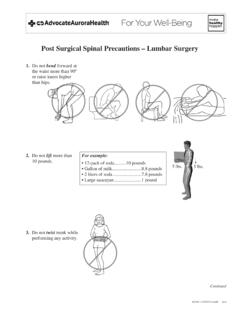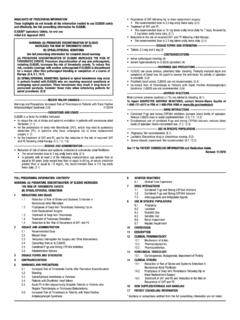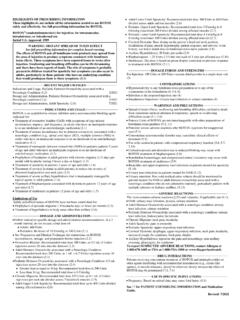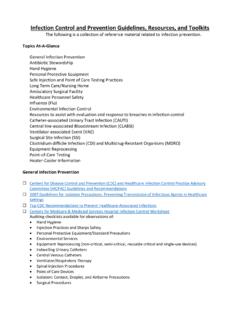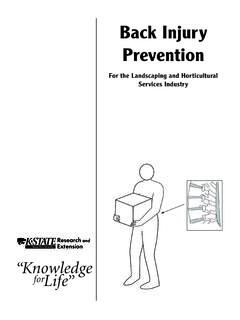Transcription of WHO basic training and safety in chiropractic
1 WHO guidelines on basic training and safety in chiropractic Geneva 2005 WHO Library Cataloguing in Publication Data World Health Organization. WHO guidelines on basic training and safety in chiropractic . education standards ISBN 92 4 159371 7 (NLM classification: WB ) World Health Organization 2005 All rights reserved. Publications of the World Health Organization can be obtained from WHO Press, World Health Organization, 20 Avenue Appia, 1211 Geneva 27, Switzerland (tel: +41 22 791 2476; fax: +41 22 791 4857; email: Requests for permission to reproduce or translate WHO publications whether for sale or for noncommercial distribution should be addressed to WHO Press, at the above address (fax: +41 22 791 4806; email: The designations employed and the presentation of the material in this publication do not imply the expression of any opinion whatsoever on the part of the World Health Organization concerning the legal status of any country, territory, city or area or of its authorities, or concerning the delimitation of its frontiers or boundaries.))
2 Dotted lines on maps represent approximate border lines for which there may not yet be full agreement. The mention of specific companies or of certain manufacturers products does not imply that they are endorsed or recommended by the World Health Organization in preference to others of a similar nature that are not mentioned. Errors and omissions excepted, the names of proprietary products are distinguished by initial capital letters. All reasonable precautions have been taken by WHO to verify the information contained in this publication. However, the published material is being distributed without warranty of any kind, either express or implied. The responsibility for the interpretation and use of the material lies with the reader. In no event shall the World Health Organization be liable for damages arising from its use.
3 Printed in Switzerland Contents Acknowledgements ..i Introduction .. 1 Objectives .. 2 How to use this document .. 2 Glossary .. 3 Part 1: basic training in 5 1. General considerations .. 5 Historical information .. 5 Philosophy and basic theories of 5 Administrative and academic considerations .. 6 Monitoring and evaluation .. 6 Further education and career 7 2. Acceptable levels of education and 7 Category I full chiropractic 7 Category II limited chiropractic 7 3. Models of chiropractic 8 Category I(A) .. 8 Category I(B).. 8 Category II(A).. 8 Category II(B).. 9 4. Full chiropractic education category I(A).. 9 9 Entrance 9 basic 9 Core 10 5. Full chiropractic education category I(B) .. 13 13 Special 13 basic 13 6.
4 Limited chiropractic education category II(A) .. 14 14 Special 14 basic 14 7. Limited chiropractic education category II(B).. 15 15 Special 15 basic 15 8. Assessment and examination of students in 16 9. Primary health care workers and 16 Primary health care workers myotherapists .. 16 16 Course 17 Method and duration of training .. 17 Part 2: Guidelines on safety of chiropractic .. 19 1. 19 2. Contraindications to spinal manipulative therapy .. 20 Absolute contraindications to spinal manipulative therapy .. 21 3. Contraindications to joint manipulation by category of 22 Articular derangement .. 22 Bone weakening and destructive 23 Circulatory and haematological 23 Neurological disorders.
5 23 Psychological 24 4. Contraindications to adjunctive and supportive therapies .. 24 24 Exercises and supplementary supportive 24 5. Accidents and adverse 25 Causes of complications and adverse reactions .. 25 Examples of inappropriate practices .. 25 Serious adverse 25 Vascular 26 Prevention of complications from manipulation .. 27 6. First aid 27 Annex 1: List of participants .. 29 Annex 2: A sample four year, full time accredited 33 Annex 3: A sample full (conversion) 35 Annex 4: A sample limited (conversion) programme .. 37 Annex 5: A sample limited (standardization) 39 References .. 41 iAcknowledgements The World Health Organization (WHO) greatly appreciates the financial and technical support provided by the Regional Government of Lombardy, Italy, for the development and publication of these guidelines, as part of the implementation of collaborative projects with WHO in the field of traditional medicine.
6 The Region of Lombardy kindly hosted and provided financial support for the WHO Consultation on chiropractic , held in Milan, Italy, in December 2004. Thanks to Dr John A. Sweaney, New Lambton, Australia, who prepared the original text. WHO acknowledges its indebtedness to over 160 reviewers, including experts and national authorities and professional and nongovernmental organizations, in over 54 countries who provided comments and advice on the draft text. Special thanks are due to participants of the WHO Consultation on chiropractic (see Annex 1), who worked towards reviewing and finalizing the draft guidelines, and to the WHO Collaborating Centre for Traditional Medicine at the State University of Milan, Italy, in particular to Professor Umberto Solimene, the Director, and to Miss Elisabetta Minelli, the International Liaison Officer, for their assistance to WHO in organizing the Consultation.
7 Foreword During the last decade, the use of traditional and complementary/alternative medicine (TM/CAM) has increased considerably not only in developing countries, where it often represents the only possibility for health protection, but also in developed countries. The percentage of the population that uses TM/CAM is in the order of 50% in many of high income countries, such as Canada, France, Germany, United Kingdom and United States of America. This occurs also in Italy (not less than 15%) as well as for certain Italian regions, including the Lombardy Region, where the percentage is around 20% and continues rising. Facing this challenge, it is extremely important to create the conditions for the correct and appropriate use of methods which, if used correctly, can contribute to the protection and enhancement of citizens health and well being.
8 The development of these practices can only be obtained according to safety , efficacy and quality criteria. Such principles characterize the modern medical practice and are the essential basis for consumers protection. TM/CAM activities undertaken by the Regional Government of Lombardy have always been guided by the abovementioned criteria. TM/CAM was included in the Regional Community Healthcare Plan (2002 2004), and a comprehensive framework for the protection of consumers and practitioners has been developed accordingly thanks to a series of administrative provisions. The four year cooperation plan between the World Health Organization and the Regional Government of Lombardy on the use and evaluation of TM/CAM is a keystone in such a process. The promotion of several clinical and observational studies on the regional territory is also to be considered an important step for the evaluation of the efficacy of TM/CAM methods.
9 The quality of the practice depends mainly on the training performed by the practitioner. For this reason, the Regional Government of Lombardy supported the development of the WHO Guidelines on basic training and safety in chiropractic that aim at defining the requisites for chiropractic practitioners. The process of development of these Guidelines included the WHO Consultation meeting held in Milan in December 2004, which brought together experts, national authorities and professional organizations from all over the world. One of the conclusions of the Consultation was that these guidelines were appropriate as resources not only for the Lombardy Region, but also for various country situations worldwide. With this in mind, this document is to be considered an important reference point for those, among practitioners, political and administrative authorities, that want chiropractic to be a safe and efficacious aid for citizens health and for any regulatory and licensing act.
10 Alessandro C Regional Minister of Health Regional Government of Lombardy Giancarlo Abelli Regional Minister of Family and Social Solidarity Regional Government of Lombardy iiIntroduction 1 Introduction chiropractic is one of the most popularly used forms of manual therapy. It is now practised worldwide and regulated by law in some 40 national jurisdictions. As a health care service, chiropractic offers a conservative management approach and, although it requires skilled practitioners, it does not always need auxiliary staff and therefore generates minimal add on costs.










